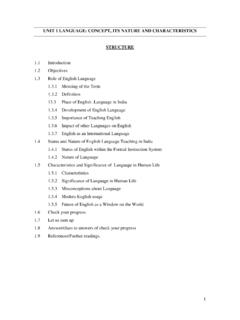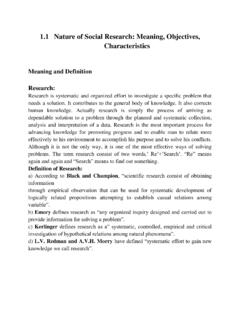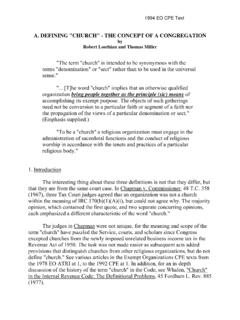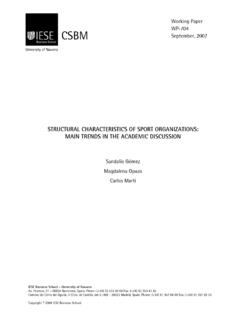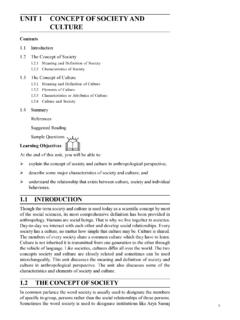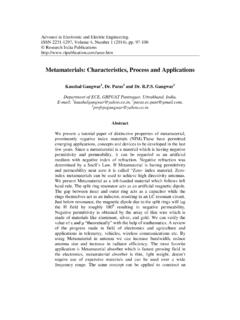Transcription of Administration Concept - Jiwaji University
1 UNIT-I Difference Between Administration And Management Definition of Management : Management is defined as an act of managing people and their work, for achieving a common goal by using the organization s resources. It creates an environment under which the manager and his subordinates can work together for the attainment of group objective. It is a group of people who use their skills and talent in running the complete system of the organization. It is an activity, a function, a process, a discipline and much more. Planning, organizing, leading, motivating, controlling, coordination and decision making are the major activities performed by the management. Management brings together 5M s of the organization, Men, Material, Machines, Methods, and Money. It is a result oriented activity, which focuses on achieving the desired output.
2 Definition of Administration : The Administration is a systematic process of administering the management of a business organization, an educational institution like school or college, government office or any nonprofit organization. The main function of Administration is the formation of plans, policies, and procedures, setting up of goals and objectives, enforcing rules and regulations, etc. Administration lays down the fundamental framework of an organization, within which the management of the organization functions. The nature of Administration is bureaucratic. It is a broader term as it involves forecasting, planning, organizing and decision-making functions at the highest level of the enterprise. Administration represents the top layer of the management hierarchy of the organization.
3 These top level authorities are the either owners or business partners who invest their capital in starting the business. They get their returns in the form of profits or as a dividend. Key Differences Between Management and Administration The major differences between management and Administration are given below: 1. Management is a systematic way of managing people and things within the organization. The Administration is defined as an act of administering the whole organization by a group of people. 2. Management is an activity of business and functional level, whereas Administration is a high-level activity. 3. While management focuses on policy implementation, policy formulation is performed by the Administration . 4. Functions of Administration include legislation and determination. Conversely, functions of management are executive and governing.
4 5. Administration takes all the important decisions of the organization while management makes decisions under the boundaries set by the Administration . 6. A group of persons, who are employees of the organization, is collectively known as management. On the other hand, Administration represents the owners of the organization. 7. Management can be seen in the profit making organization like business enterprises. Conversely, the Administration is found in government and military offices, clubs, hospitals, religious organizations and all the non-profit making enterprises. 8. Management is all about plans and actions, but the Administration is concerned with framing policies and setting objectives. 9. Management plays an executive role in the organization. Unlike Administration , whose role is decisive in nature. 10. The manager looks after the management of the organization, whereas administrator is responsible for the Administration of the organization.
5 11. Management focuses on managing people and their work. On the other hand, Administration focuses on making the best possible utilization of the organization s resources. Basis For Comparison Management Administration Meaning An organized way of managing people and things of a business organization is called the Management. The process of administering an organization by a group of people is known as the Administration . Authority Middle and Lower Level Top level Role Executive Decisive Applicable to Profit making organizations, Government offices, military, clubs, business Conclusion: Theoretically, it can be said that both are different terms, but practically, you will find that the terms are more or less same. You would have noticed that a manager performs both administrative and functional activities. Although the managers who are working on the top most level are said to be the part of Administration whereas the managers working on the middle or lower level represents management.
6 So, we can say that Administration is above management. business organizations. enterprises, hospitals, religious and educational organizations. Work Putting plans and policies into actions. Formulation of plans, framing policies and setting objectives Function Executive and Governing Legislative and Determinative Focus on Managing work Making best possible allocation of limited resources. Organization: Meaning, Definition, Concepts and Characteristics Definitions: Louis Allen, Organization is the process of identifying and grouping work to be performed, defining and delegating responsibility and authority and establishing relationships for the purpose of enabling people to work most effectively together in accomplishing objectives. Koontz and O Donnell, The establishment of authority relationships with provision for co-ordination between them, both vertically and horizontally in the enterprise structure .
7 George Terry, Organizing is the establishing of effective authority relationships among selected work, persons, and work places in order for the group to work together efficiently . Concepts of Organization: There are two concepts of organization: 1. Static Concept 2. Dynamic Concept 1. Static Concept : Under static Concept the term organization is used as a structure , an entity or a network of specified relationship. 2. Dynamic Concept : Under dynamic Concept , the term organization is used as a process of an on-going activity. In this sense, organization is a process of organizing work, people and the systems. Dynamic Concept lays emphasis on individuals and considers organization as a continuous process. Characteristics of Organization: Organization is the establishment of authority relationship among persons so that it helps in the achievement of organizational objectives.
8 Some of the characteristics of organization are studied as follows: 1. Division of Work: Organization deals with the whole task of business. The total work of the enterprise is divided into activities and functions. Various activities are assigned to different persons for their efficient accomplishment. This brings in division of labour. It is not that one person cannot carry out many functions but specialization in different activities is necessary to improve one s efficiency. Organization helps in dividing the work into related activities so that they are assigned to different individuals. 2. Co-Ordination: Co-ordination of various activities is as essential as their division. It helps in integrating and harmonizing various activities. Co-ordination also avoids duplications and delays. In fact, various functions in an organization depend upon one another and the performance of one influences the other.
9 Unless all of them are properly coordinated, the performance of all segments is adversely affected. 3. Common Objectives: All organizational structure is a means towards the achievement of enterprise goals. The goals of various segments lead to the achievement of major business goals. The organizational structure should build around common and clear cut objectives. This will help in their proper accomplishment. 4. Co-operative Relationship: An organization creates co-operative relationship among various members of the group. An organization cannot be constituted by one person. It requires at least two or more persons. Organization is a system which helps in creating meaningful relationship among persons. The relationship should be both vertical and horizontal among members of various departments.
10 The structure should be designed that it motivates people to perform their part of work together. 5. Well-Defined Authority-Responsibility Relationships: An organization consists of various positions arranged in a hierarchy with well defined authority and responsibility. There is always a central authority from which a chain of authority relationship stretches throughout the organization. The hierarchy of positions defines the lines of communication and pattern of relationships. NATURE OF ORGANIZATION The nature of organization can be viewed in two ways: (1) Organization as a process (2) Organization as a structure or framework of relationship (1) Organization as a Process: As a process, organization is an executive function. It becomes a managerial function involving the following activities: (i) Determining activities necessary for the accomplishment of the business objectives, (ii) Division of work, (iii) Grouping of inter-related activities, (iv)Assigning duties to persons with requisite competence, (v) Delegating authority, and (vi) Co-ordinating the efforts of different persons and groups.
